Plan checklist
Edwards
191 Snake River Line, Snake River
Planting plan created by Muskrat Watershed Council
Schedule A:
Plants & Property
Land Characteristics
This planting plan is designed based on the land characteristics identified during the day of the site visit. Plants are chosen according to the soil and light conditions on your property. The number of plants chosen for each planting compartment takes into account the square metre area of the space, as well as the amount of current vegetation cover. Your property is part of ecoZone: 4b
Land Characteristics by Compartment
| Length | Width | Area | pH | Soil | Moisture | Light | Height | |
|---|---|---|---|---|---|---|---|---|
| A | 473m | 18m | 8514m2 | normal | loamy, clay | normal, moist | full sun | any |
| B | 80m | 40m | 1600m2 | loamy, clay | normal, moist, wet | full sun | any | |
| 553m | 29m | 10114m2 |
Plant Selection Summary
The following shrubs and trees are chosen for their suitability and survivability given the current soil and light conditions in each compartment on your property, as well as preferable features.
| Plant Species | A | B | Potted | Bareroot | Wildflower |
|---|---|---|---|---|---|
| Nannyberry | 1000 | 200 | 1200 | ||
| Red Osier Dogwood | 1300 | 1300 | |||
| Highbush Cranberry | 1000 | 200 | 1200 | ||
| Pussy Willow | 400 | 100 | 500 | ||
| Tamarack | 290 | 50 | 340 | ||
| Gray Dogwood | 100 | 200 | 300 | ||
| Subtotal | 4090 | 750 | 0 | 4840 | 0 |
| Totals | 4840 | ||||
Plant Information
The following table summarizes key information about each plant selected for your property.
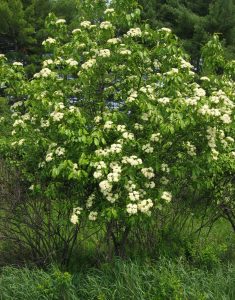
|
NannyberryHeight: 3 m
Nannyberry is a large deciduous shrub species that typically grows about 3 m in height. The leaves are dark green, ovate shaped, oppositely arranged, have a pointed tip, and have finely toothed margins. The flowers are showy, white colored, appear in flat topped clusters, and bloom in May. These flowers produce blueish black berries, which are edible to humans and persist throughout the winter. The flowers are beneficial to pollinator species , like bees and butteries. The fruit is beneficial to wildlife species, including birds and small mammals. This shrub has attractive fall foliage. The root system is extensive, making this plant valuable for controlling erosion and stabilizing loose soil. This shrub can be pruned to have a single stem and grown as a small tree instead of a shrub.
|
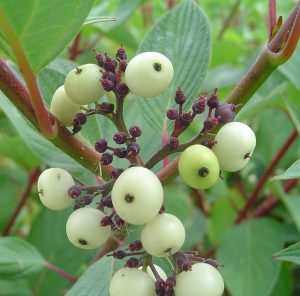
|
Red Osier DogwoodHeight: 1.5-4m
The Red Osier Dogwood is a medium-sized, deciduous shrub native throughout Northern and Western North America which typically grows to 1.5-4m. This species is multi-stemmed with numerous erect and ascending bright red branches that create a loose and spreading form. Leaves produced are simple, two-toned with a dark green upper side and light green underside. They are arranged opposite each other along the branches. During the fall, the foliage turns a brilliant red to dark purple. Clusters of small, creamy white flowers form on the terminal ends of the branches between June and July. The Red Osier Dogwood produces blueish-white fruiting bodies during late summer, which may persist throughout the winter. This shrub's berries provide an important winter food source for numerous species, from large deer to small wintering birds.
|
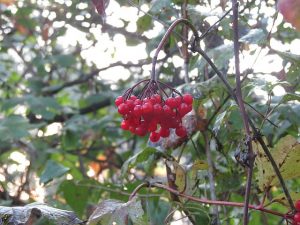
|
Highbush CranberryHeight: 3 m
Highbush Cranberry is a large deciduous shrub species that typically grows about 3 m in height. The branches on this shrub are dense with arching stems, creating a full form. The leaves are oppositely arranged, Maple leaf shaped, have 3 lobes, and have entire or toothed margins. The flowers are showy, creamy white coloured, appear in flat clusters with larger florets surrounding smaller ones, and bloom between May and June. These flowers change into drooping, bright red berry clusters that persist throughout the winter. While the berries are edible to humans, they are very tart when consumed raw so are typically cooked first. This shrub has very attractive fall foliage, changing a reddish purple colour. The flowers are beneficial to pollinator species, like bees and butterflies. The fruit is beneficial to wildlife species, including birds and small mammals. The root system is extensive, making this shrub valuable for controlling erosion and stabilizing loose soil. This species can be found across Canada from Newfoundland to British Columbia, but is most commonly found in Ontario and Quebec.
|
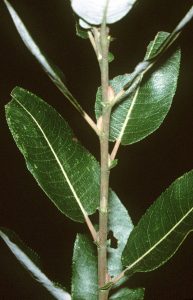
|
Pussy WillowHeight: 6m
The Pussy Willow is a fast growing, deciduous shrub or small tree found reaching heights of 6m, and is from British Columbia to Newfoundland. This species grows from shoots extending from the base of the trunk, creating a multi-stemmed, tall, round bush. The Pussy Willow is an ideal species for bank stabilization and erosion control due to its large, fibrous root system and love of water. This species branches extend from the main shoots and are usually hairy and reddish-brown in colour. The main shoots of Pussy Willow are smooth and greyish-brown, becoming scaly with age. It produces simple, narrow, lance-shaped leaves alternately arranged along the branch. The Pussy Willow yields purple-brown fuzzy catkins which will form long-beaked and finely haired capsules during May and June.
|
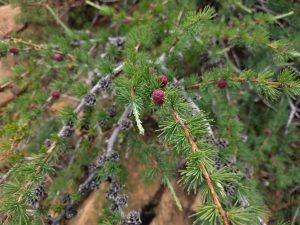
|
TamarackHeight: 20 m
Tamarack is a small to medium sized, deciduous coniferous tree species that grows up to 20 m tall. This plant may also be known by the common name American Larch. The bark is scaly and reddish brown coloured. The needles are delicate, 2-4 cm long, blueish-green coloured, grow in clusters of 15 to 25, and change golden yellow in the fall. This tree provides food and habitat for wildlife species, including birds and mammals. Tamarack is a fast-growing, long lived species that can live up to 150 years and is found across all of Canada. The wood from this tree is decay-resistant and has been used to make railway ties, posts, and crates. Tamarack is considered unique because it is the only conifer species to drop its needles in the fall.
|
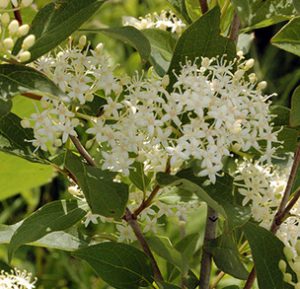
|
Gray DogwoodHeight: 2-3m
The Gray Dogwood, also referred to as Northern Swamp Dogwood or Panicle Dogwood, is a medium-sized, deciduous shrub which typically grows 2-3m. This species is multi-stemmed, with a full, round form. The leaves are green and arranged alternately along the branches. During the fall, leaves turn a bright red to deep purple colour. Between May and June, showy clusters of small white flowers bloom. These flowers turn into white fleshy berries late in the summer. The reddish-pink stems hold the berries throughout the winter, creating an artful contrast to the gray bark and snowy scenery. The Gray Dogwood is tolerant of a variety of environmental conditions and its complex, fibrous root system make it an ideal plant to use for controlling erosion.
|
Compartment A
Naturalization Area
Will setup electric wire around planting area. Plant in the “triangle”. pH: normal
pH: normal Depth: bareroot
Depth: bareroot-
 Moisture: normal, moist
Moisture: normal, moist -
 Soil Type: loamy, clay
Soil Type: loamy, clay  Plant Height: any
Plant Height: any-
 Light conditions: full sun
Light conditions: full sun
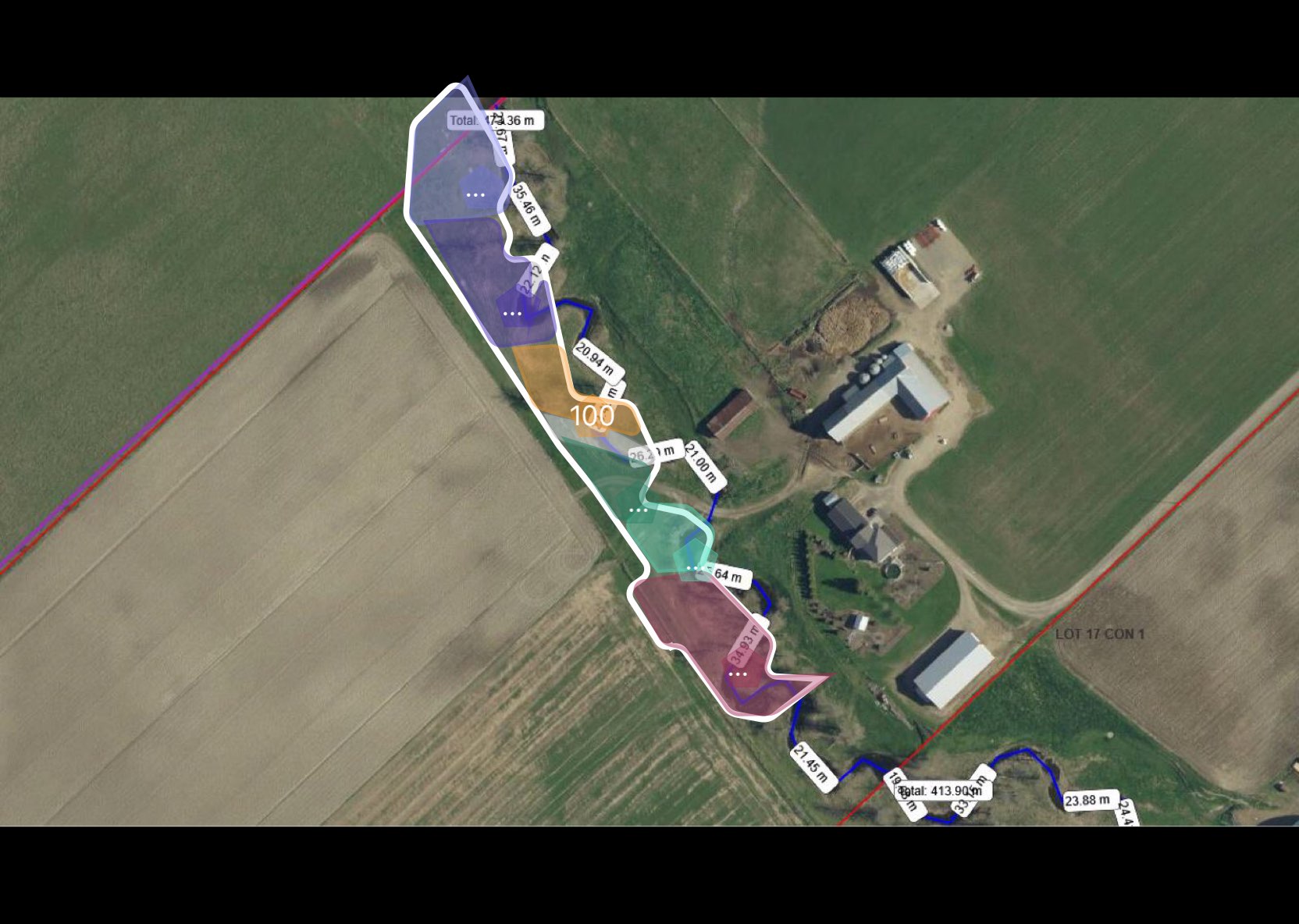
Compartment B
Naturalization Area
 Depth: bareroot
Depth: bareroot-
 Moisture: normal, moist, wet
Moisture: normal, moist, wet -
 Soil Type: loamy, clay
Soil Type: loamy, clay  Plant Height: any
Plant Height: any-
 Light conditions: full sun
Light conditions: full sun
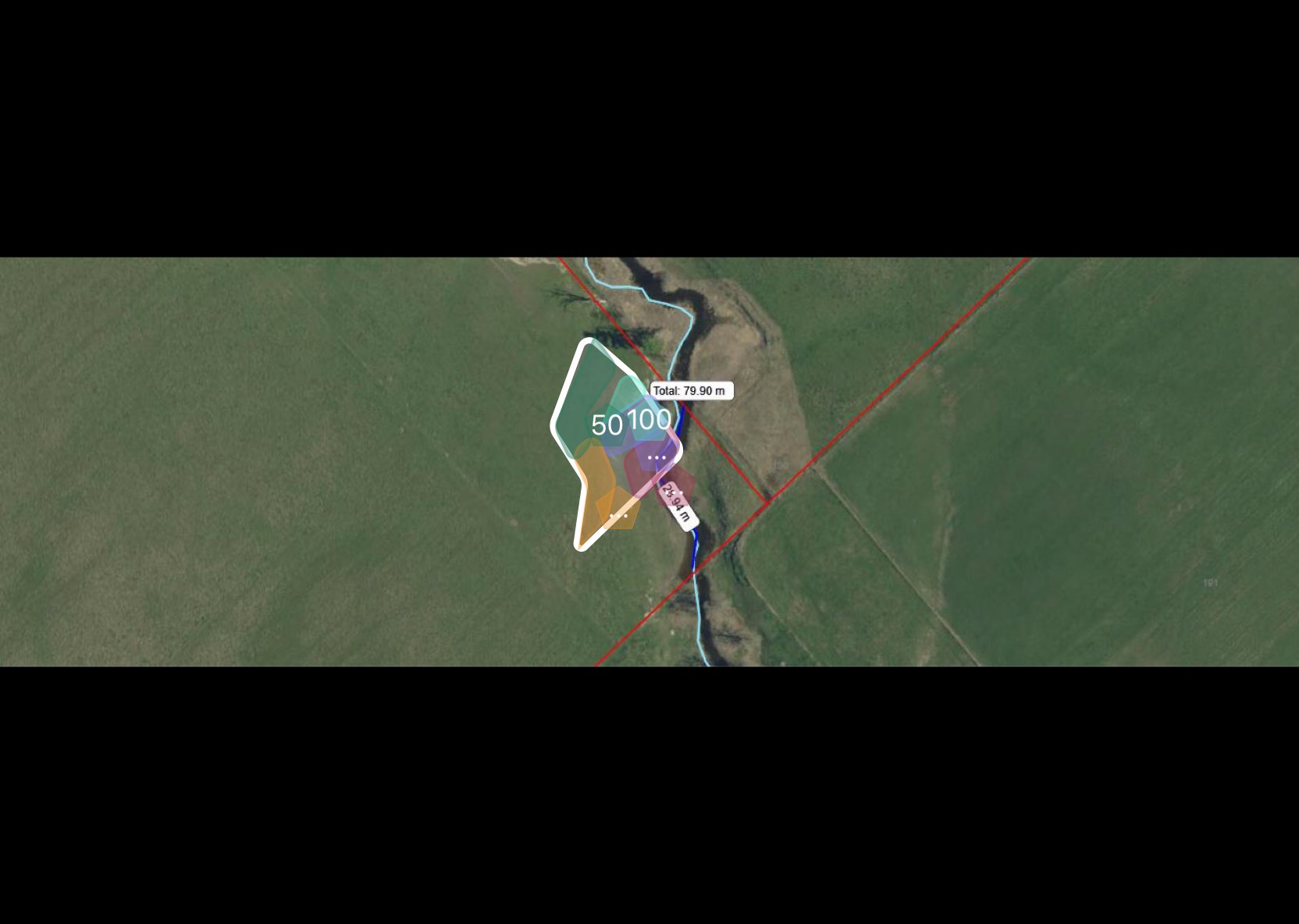
Schedule B
Financial Summary
Project Partners: Watersheds Canada and Muskrat Watershed Council
The following section outlines the total cost of your project. It has been divided into 2 sections; 1- Plants and Material, 2- Services. It also includes the breakdown of the landowner contribution and the portion that will be paid by Watersheds Canada, as outlined in the Project Costs Total table.
The Natural Edge program has received generous funding to help support the costs of plants, materials, and project coordination and delivery, making this program possible.
Bareroot stock |
|||
| Item | Quantity | Cost/Item | Subtotal |
|---|---|---|---|
| Nannyberry | 1200 | 2.25 | 2700.00 |
| Red Osier Dogwood | 1300 | 2.25 | 2925.00 |
| Highbush Cranberry | 1200 | 2.25 | 2700.00 |
| Pussy Willow | 500 | 2.25 | 1125.00 |
| Tamarack | 340 | 2.25 | 765.00 |
| Gray Dogwood | 300 | 2.25 | 675.00 |
| Total Bareroot plant stock | 4840 | 10890.00 |
Tending materials |
|||
| Item | Quantity | Cost/Item | Subtotal |
|---|---|---|---|
| Mulch | 4840 | 1.00 | 4840.00 |
| Total Tending materials | 4840.00 |
Totals
| 1-Plants and materials | |
|---|---|
| Bareroot plant stock | 10890.00 |
| Wildflower plant stock | 0.00 |
| Tending materials | 4840.00 |
| Plants & Materials | 15730.00 |
| 2-Services | Quantity | Cost/Item | Subtotal |
|---|---|---|---|
| Watersheds Canada's Site visit (Site visit in-kind) | 1 on 06/30/2025 | 0.00 | 0.00 |
| Plant stocking | 4840 | 2.00 | 9680.00 |
| Mulching & tree guard installation | 4840 | 1.50 | 7260.00 |
| Shipping & handling of materials | 25.00 | ||
| Planting plan | 350.00 | ||
| Project management and delivery | 400.00 | ||
| Administration fee | 100.00 | ||
| Services total | 17815.00 |
| Total Project Costs | Subtotal |
|---|---|
| Total project value (including in kind contributions) | 33545.00 |
| Total eligible costs (excluding in kind contributions) | 33545.00 |
| Muskrat Watershed Council's contribution (100% of eligible costs) | 33545.00 |
| Landowner contribution (0% of eligible costs) | 0.00 |
Schedule C
Project Agreement
Stewardship Agreement
Please indicate your agreement to this proposed plan by signing the following Stewardship Agreement and submitting it, along with your financial contribution, to:
Watersheds Canada
115-40 Sunset Blvd. Perth, ON, K7H 2Y4
Plant Availability
Please note that plant species may need to be changed based on plant stock availability at the time of ordering.
Project Completion
Upon receiving your signed stewardship agreement and financial contribution, a date will be booked to complete the project. Watersheds Canada will supply all plants, materials, and planting labour. If there are particular dates that you would prefer, we will do our best to accommodate your requests.
The Natural Edge Stewardship Agreement with Watersheds Canada
Agreement made this Day of the Month of in the Year .
BETWEEN Stephen and Janet Edwards 191 Snake River Line Ontario K0J1K0 (Hereinafter called the OWNERS)
AND Watersheds Canada, 115-40 Sunset Blvd, Perth, ON, K7H 2Y4 (Hereinafter called WC)
WHEREAS the Owners and WC have met and discussed plans for shoreline naturalization on the specified area(s) in Schedule A existing on the Owners’ land;
WHEREAS the Owners indicate approval of the project as proposed; and
WHEREAS the project is, or will be for the benefit of the Owners and others;
NOW THEREFORE THE PARTIES AGREE AS FOLLOWS:
1. This Agreement shall be in effect for a period of 5 years, commencing with the date of this Agreement.
2. The Owners and WC agree that the areas where the work is to be performed is as described in Schedule A.
3. The Owners grant WC, its contractors, employees and agents, the right to enter the property to perform the work agreed upon as outlined in Schedule A. In addition, WC, its contractors, employees and agents may inspect the work performed for the purposes of monitoring the project and survival assessment, with prior agreement with Owners for date and time of inspection.
4. The Owners agree to contribute the “Landowner contribution (0% of eligible costs)” and pay the costs indicated in Schedule B.
5. In instances where the Owners are to pay WC for work to be performed (outlined in Schedule A), the Owners agree to provide payments to WC prior to the commencement of that operation. Failure of payment shall constitute a breach of this Agreement and the Owners agree this Agreement will be terminated and thereupon the Owners agree to pay WC the estimated costs of the operations of the project completed, if any.
6. The Owners agree, if necessary, to perform a reasonable amount of maintenance, which is described in the Native Plant Care Guide, available at watersheds.ca.
7. If the contractor is required to perform the work outlined in Schedule A, then the contractor carrying out the work on the land described will be required to take out and furnish evidence of a comprehensive policy of public liability and property damage coverage. The contractor and their workers will be required to be in good standing with the Workplace Safety and Insurance Board prior to performing the work.
8. The Owners agree not to remove, destroy or alter the project without prior consultation and approval of WC. Pruning and trimming planted nursery stock, or adding replacement native nursery stock is exempt.
9. The Owners agree not to mow the planted area.
10. The Owners do acknowledge that WC, its contractors, employees and agents, having performed said works, are not under further obligation with respect to survival of nursery stock, inspection, or maintenance.
11. The Owners, in the absence of negligence, hereby remises, releases and forever discharges WC, its contractors, employees and agents from all claims and demands for injuries, including death, loss, damages and costs in any way related to or connected with installation and maintenance of the work described or resulting from any deleterious effects of the work to the land or to the lands and buildings thereon retained by the Owners.
IN WITNESS WHEREOF the parties have agreed to the contents of this plan; SIGNED:
About this program
This project is created as a co-partnership between Watersheds Canada and Muskrat Watershed Council
About Muskrat Watershed Council
We are a volunteer, community-based, not-for-profit organization with the goal of improving water quality in the Muskrat Lake Watershed by using scientific and local based knowledge. We seek to engage and empower people and communities by promoting best management practices in an effort to identify and reduce nutrient loading from all sources in the Watershed. Through these objectives, we hope to foster economic, societal and environmental sustainability.
This program was created by Watersheds Canada
We believe that every person has the right to access clean and healthy lakes and rivers in Canada. At Watersheds Canada, we work to keep these precious places naturally clean and healthy for people and wildlife to continue using for years to come. We love working with others to meet the needs of local communities, whether you’re a concerned citizen, a landowner, a lake association looking for help, or a coalition of groups interested in activating your local community.

